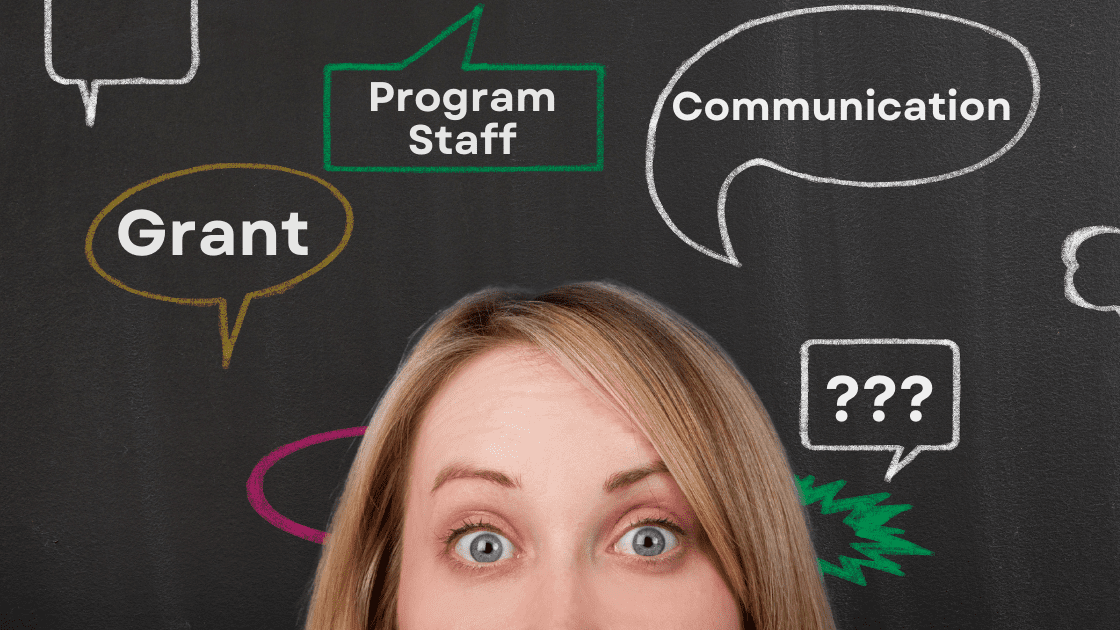It takes a lot of work for a nonprofit to seek a grant, execute the program it funds, and report on the impact. If you neglect critical steps in any of these stages, you can end up with a grant project you cannot successfully implement. With decades of experience working in nonprofits, our staff witnessed some horror stories when there was a lack of communication between grant writers and the Program Director who carried out the grant project. This article shares a few of these nightmare scenarios and offers guidance on why grant writers should coordinate with Program Directors–before writing the proposal.
From our staff’s catalog of horror stories, imagine this scene. As part of the development team, you write the grant proposals at your nonprofit organization. In fact, you wrote the proposal for a grant that was just awarded to your school for children with learning challenges. The grant will fund an afterschool program bringing children and parents together for storytelling, painting, and other art activities. You even included the cost to serve pizza in the budget. The parents and children are going to love it! But when you tell the school’s Program Director the excellent news and the details of the grant, you do not receive the jubilant response you expected. Instead, the Program Director is worried and confused. The grant-funded project YOU outlined will have at least 10% parent participation at each afterschool event. With 500 children enrolled, at least 50 parents must attend each monthly session. The Program Director tells you that they are lucky to have five parents attend any afterschool activity. “Parents are busy,” she says. “They are rushing to get home to make dinner for their whole family.” No amount of pizza will attract 50 parents each session.” The school will not have the inputs (parents) to make this project happen! To the development team, 10% participation seemed reasonable, but you need the experience of program staff to know if a project can succeed.
A nonprofit can face all sorts of challenges if a project cannot be administered according to the grant agreement. You might have to pay the money back. You might damage the relationship with the grant funder. Yet, a lack of coordination between program staff and grant writers happens more often than you think. To help you avoid a situation like this, here are some grant components you should discuss and plan with a Program Director before submitting the proposal. As you will see, it’s essential to maintain communication with the Program Director before the grant writing process begins, during implementation, and after the project is complete.
Goals
Ask the Program Director what their overarching goals are for the population you serve. What type of projects would make the biggest impact or fill gaps in service? The people with boots on the ground have a keen awareness of what would improve the quality or reach of their work. You can have this conversation before starting your grant research. This will help you find the best match between what grantors want to fund and what your organization needs.
Inputs
What will you need to execute the project? We recommend working with the Program Director at the beginning of the grant writing process to determine the inputs for the project that include materials, staff time, funds, and participants. The Program Director will be responsible for putting the project into action, so they are better equipped to foresee everything required and predict the staff time it will actually take. Accurate inputs are crucial to creating a good budget for the project. Grantors almost always request a report that details how the funds were spent, so don’t guess on your inputs!
Measuring Outcomes
When applying for a grant, grant funders like to see a history of past successes and the effectiveness of your programs. Once a grant is awarded, funders expect measurable outcomes for the project, and you will have to report on these. Having a plan to measure outcomes will also help to keep the project on track. It’s generally the program staff’s responsibility to collect data and gather information. With your Program Director, decide what indicators mean the project is reaching its goals. Higher test scores? Lower rates of homelessness? What indicators like these will show the effect the project is having? Communicate with the Program Director to design how data is collected and the outcomes measured.
We have heard several horror stories about out-of-the-loop Program Directors that were approached when the outcomes were needed for the report to the funder. Little prior communication meant the program staff didn’t know they were supposed to collect data a certain way. Or they could not measure outcomes the way it was written in the proposal. Or they didn’t track any results at all. You can imagine what happens then!
Deadlines
We suggest discussing the major deadlines for the project with the Program Director during the grant writing process. For example, when will baseline data be collected? When will the project end? When will the person writing the grant report need all the data and outcomes?
We share these stories and tips to take help take away some of the grant scaries. A thorough and well-communicated plan will make the whole grant process run smoothly. Save the horror for movie night!




